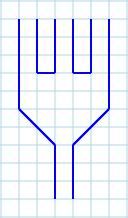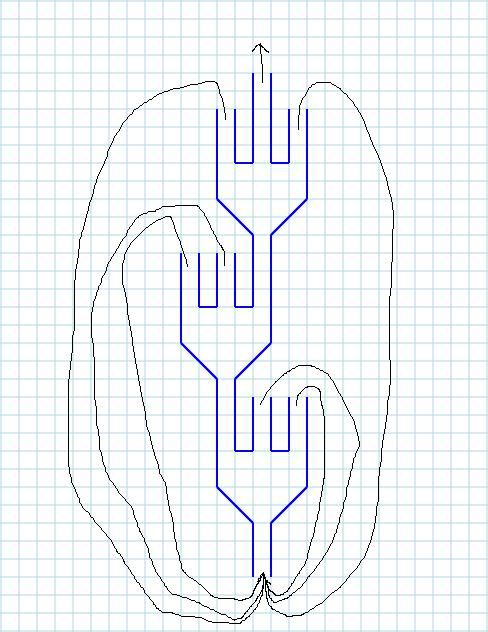I've seen Zak Smith use Super Mario Bros. as an example when talking about dungeons, primarily in the "otherness" of dungeons — there's happy music and blue skies up above, but the dungeon is foreboding, oppressive. It's a change in mood.
And Super Mario Bros. was pretty unabashedly inspired by Alice's Adventures in Wonderland, itself a known inspiration for Dungeons & Dragons dungeons (and go check out Dungeonland for Gary Gygax's direct adaptation).
Anyway, there's a trick in one of the Mario levels where platforms shape the hallway into one with three paths. Going the wrong way will cause the character to be stuck in a loop, but going through the passageways correctly will lead to the exit.
(By the way, after some research, I determined this to be World 7-4, though World 4-4 also has one.)
Why not use this trick in a dungeon? Just make a selection of hallways, and create a puzzle like this. Here's an example:
We'll say this is D&D. The characters find themselves in a little village, largely because there's a tomb nearby, and they want to loot it. The village elder spouts a lot of cryptic stuff — something about all things being true, and false, and meaningless — but he lets slip a piece of wisdom which may or may not stick with the characters, because they're just being polite and convincing him that they're foreign pilgrims who seek to pray in the temple, rather than foreign treasure-seekers who seek to loot it.
Ahem. Anyway. The village elder says the following thing, "The adolescent man, he rebels against the teachings of his elders, he seeks to couple with young women, and he seeks to experience the fullness of life. He seeks the left-hand path. The adult man, he accepts the teachings of his elders, develops a code of honor, and understands the wholeness of his mind, body, and spirit. He seeks the right-hand path. The old man, the wise man, he has walked both paths and returned with the wisdom of the enlightened. He seeks the middle path."
After another hour of tea and philosophy, the characters finally manage to extricate themselves from the old man's conversation under the pretense of a bathroom break (they just spent two hours drinking tea, after all). With his blessing, they enter the temple.
As they're walking, they come to a room that looks like this (for that matter, this might be the whole dungeon; solve this puzzle, find the hidden shrine):
 |
| This should be easy. |
 |
| This time, for sure! |
...only to find themselves in another room that looks similar to this one.
They do it again to find...
 |
| Is it just me, or do all these rooms look alike? |
...another room!
So, they decide to backtrack, but they don't pass through three rooms. Instead, they find themselves exiting the dungeon.
So, they sit and think. This is obviously magic, because there is no way for these rooms to bend back on each other. Finally, one says to the other, "Hey, didn't that old guy say something about left and right? What was that..."
After some thought, they piece together the parable and return to the dungeon. This time, they navigate according to the parable, and find that going left, then right, then straight, leads to the shrine.
Ultimately, the dungeon looks like this:
After some thought, they piece together the parable and return to the dungeon. This time, they navigate according to the parable, and find that going left, then right, then straight, leads to the shrine.
Ultimately, the dungeon looks like this:
 |
| Be jealous of my MS Paint arrows. |
Obviously, this structure can be altered. The magic that makes the dungeon "loop" could also subtly change the rooms so that it is not immediately obvious that the same room has been entered. More or fewer paths could be given. The clues could lie in the dungeon itself, or maybe the structure only loops for those who do not hold a "key." (For another Mario example, in Super Mario 64, the stairs leading to Bowser's Lair appear infinite unless the traveler has at least 70 Power Stars.)
The above images were made using Graph Paper and MS Paint.
And this is why I don't put these sorts of puzzles into my games - I just suck at generating them so that the answer is solveable but not obvious.
ReplyDeleteI'm inclined to agree with you. I haven't used these sorts of puzzles in the past, but getting more into dungeon design, I might attempt to do so in the future. This is also, in part, advice for a friend who is contemplating dungeon design.
ReplyDeleteThe advice I've always heard is that puzzles are rarely "obvious." If I recall, I played in a game where the GM made a puzzle based on the Zodiac, and every player was familiar enough with the Zodiac to solve the puzzle, but none of us got it. As a player, there's so much noise that clues can be hard to remember, so Game Masters should never feel that adding more clues is making it "too easy."